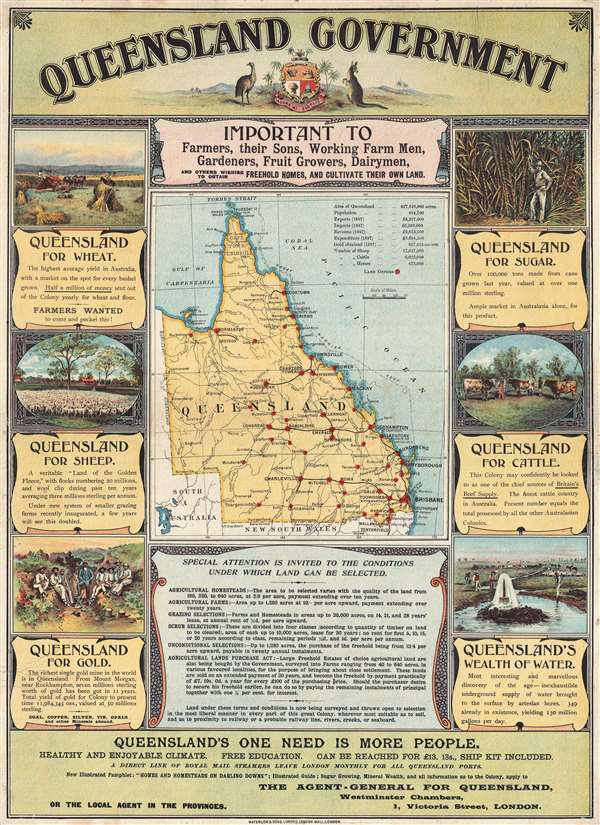This item has been sold, but you can get on the Waitlist to be notified if another example becomes available, or purchase a digital scan.
1898 Queensland Australia Propaganda Immigration Broadsheet and Map
Queensland-warterlowsons-1898
Title
1898 (undated) 19.5 x 14 in (49.53 x 35.56 cm) 1 : 10771200
Description
By the late 19th century Qeensland had gone through a series of devastating draughts from which, when this broadsheet was issued, they were still recovering. Nonetheless, the Queensland government was eager to draw more settlers and tasked its Agent-General in London to begin issuing propaganda that would draw what it considered the most desirable sort of colonists, British agricultural laborers. These were placed in country pubs, town squares, and anywhere poor farmers might encounter them. The broadside advertises how
Farmers, their Sons, Working Farm Men, Gardeners, Fruit Growers, Dairymen, and others wishing to obtain Freehold homes, and cultivate their own landcould do so in Queensland. This process is further described at bottom center where a prospectus details the 'conditions under which land can be selected.'
In the words of historian Ann Haebich,
Government spin to attract British migrants became more audacious over the decades. Their outrageous claims give growing support for the 'imagined Queensland' argument. In 1898 when the state was still recovering from disastrous droughts and unprecedented levels of unemployment a government poster proclaimed ‘Queensland’s one need is more people’ and promised British families a ‘healthy and enjoyable climate, free education.’This broadsheet propaganda piece relating to the early colonization of Australia is extremely rare and few have survived. It was printed by Waterlow and Sons of London. One other similar broadsheet is recorded at the National Library of Australia. That broadsheet focuses on town lots, but bears similar jargon and typography, and was also issued by the Agent-General for Queenlsand in London, probably also printed by Waterlow and Sons. Of the present broadsheet map, research suggests there is only one other surviving example, that being housed in the Queensland State Library.
Cartographer
Waterlow and Sons (1810 - 1961) was a British engraving and printing concern active in London specializing in currency, postage stamps, bond certificates, and occasionally maps. The firm was founded by James Waterlow (1790 - 1876) in 1810 on Birchin Lane, London, as a legal document printer and copyist. By 1852, they had expanded into stamps and his sons, Albert, Alfred, Sydney, and Walter joined the business. One year after James Waterlow's death, in 1877, infighting among the sons led Alfred Waterlow to split off, forming Waterlow Brothers and Layton. The rift was settled by 1920, and the two firms once again merged under the Waterlow and Sons imprint. They were involved in the Portuguese Bank Note Affair of 1925, wherein the Portuguese fraudster Artur Virgílio Alves Reis convinced the firm to print 200,000 banknotes of 500 Portuguese Escudos each, amounting to roughly 88% of Portugal's GDP. The affair was settled in court with a ruling against Waterlow. In 1928, Waterlow lost its most lucrative contract, printing English banknotes, and began to fall into decline. In 1961, they were acquired by Purnell and Sons who, shortly afterwards, sold the firm to De La Rue. Ironically, De La Rue acquired the contract to print Bank of England banknotes again in 2003 – 75 years after Waterlow lost it! More by this mapmaker...

